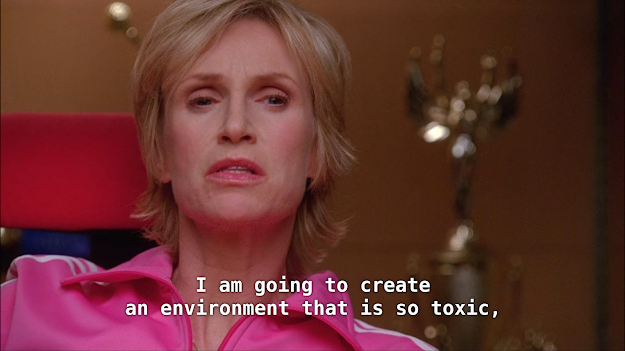Introduction:
Welcome, dear readers, to a rather unconventional blog post titled "I Am Going to Create an Environment So Toxic." Before you raise an eyebrow or close this tab in sheer disbelief, let me assure you that this title is meant to provoke thought and initiate a discussion on the importance of creating a healthy, positive environment instead. So, buckle up and join me on this insightful journey as we explore the impacts of toxic environments and the steps we can take to foster positive change.
The phrase "I am going to create an environment so toxic" is generally used figuratively to express a person's intention or desire to cultivate a negative, harmful, or destructive atmosphere or situation. However, it's important to note that creating a toxic environment is not a positive or productive goal, and it can have detrimental effects on individuals and relationships.
In a literal sense, creating a toxic environment refers to intentionally fostering an atmosphere characterized by negativity, hostility, manipulation, and unhealthy behaviors. This can involve spreading rumors, engaging in gossip, promoting conflict, undermining others, or engaging in any behavior that harms the well-being and emotional health of individuals within that environment.
While the phrase may be used humorously or metaphorically in certain contexts, it's crucial to promote positivity, respect, and healthy interactions in our surroundings. Creating a toxic environment can have long-lasting consequences, including damaged relationships, emotional distress, and negative impacts on personal well-being.
Instead, it is advisable to strive for creating environments that encourage growth, empathy, collaboration, and overall positivity. Fostering a supportive and nurturing atmosphere allows individuals to thrive, promotes healthy relationships, and contributes to a harmonious and productive community.
While the phrase may be used humorously or metaphorically in certain contexts, it's crucial to promote positivity, respect, and healthy interactions in our surroundings. Creating a toxic environment can have long-lasting consequences, including damaged relationships, emotional distress, and negative impacts on personal well-being.
Instead, it is advisable to strive for creating environments that encourage growth, empathy, collaboration, and overall positivity. Fostering a supportive and nurturing atmosphere allows individuals to thrive, promotes healthy relationships, and contributes to a harmonious and productive community.
The Allure of Toxicity:
In today's fast-paced world, getting caught up in the allure of negativity and toxicity is easy. Whether it's the gossip-fueled reality TV shows or the endless streams of negative news on social media, toxic environments seem to grab our attention effortlessly. Why is that? Perhaps the adrenaline rush comes from indulging in drama or the sense of validation we find in comparing ourselves to others. Nevertheless, it's crucial to recognize the long-term effects of immersing ourselves in such toxic environments.
The Hidden Dangers:
Toxic environments can have severe consequences on our mental, emotional, and even physical well-being. They can lead to increased stress levels, anxiety, depression, and a decrease in overall happiness. Toxic environments are like slow poison, gradually corroding our positivity, confidence, and self-esteem. Moreover, they can impact our relationships, hinder personal growth, and create a perpetual cycle of negativity that is difficult to break free from.
Breaking the Cycle:
Now that we understand the dangers of toxic environments, it's time to shift our focus toward creating positive change. We must actively work towards building environments that promote growth, empathy, and support. Let's dive into some practical steps we can take to create healthier spaces:
1. Self-reflection: Start by examining your own behaviors and attitudes. Are you inadvertently contributing to toxic environments through gossip, negativity, or judgment? Developing self-awareness is the first step toward positive change.
2. Surround yourself with positivity: Seek out individuals who radiate positivity and create a circle of friends who inspire and motivate you. Remember, you are the average of the people you spend the most time with, so choose wisely.
3. Practice empathy and compassion: Toxicity often thrives when there is a lack of understanding and empathy. Take the time to listen to others without judgment and try to put yourself in their shoes. Cultivating compassion helps break down barriers and promotes a healthier environment.
4. Set boundaries: Establishing boundaries is essential for maintaining a healthy environment. Learn to say no to toxic relationships, situations, or commitments that drain your energy and hinder your growth.
5. Lead by example: Be the change you wish to see. By embodying positivity, kindness, and respect, you can inspire others to do the same. Small acts of kindness can have a ripple effect, creating a more positive environment for everyone involved.
Embracing Positivity:
Creating a toxic environment may seem tempting in the short term, but it only perpetuates negativity and hinders personal growth. Let us collectively shift our focus towards embracing positivity and fostering environments that nourish our minds, hearts, and souls.

Conclusion
As we conclude this thought-provoking blog post, I hope it has served as a wake-up call to the dangers of toxic environments and the importance of actively creating positive spaces. Let us remember that each of us has the power to influence the environments we inhabit, whether it's our workplace, social circle, or online communities.
By taking responsibility for our own actions and striving to spread positivity, empathy, and compassion, we can create environments that empower, uplift, and foster growth. So, let's unite in our pursuit of a healthier, happier, and more supportive world.
Remember, dear readers, the choice is ours: to create an environment so toxic or to build a space filled with love, understanding, and hope. The decision lies in our hands.






